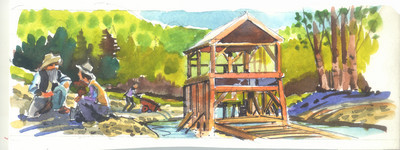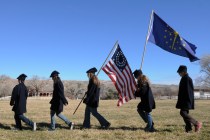Relive the gold rush by visiting where it all started
The forbidding deserts and formidable mountains of that part of the West that became Nevada lay nearly trackless in the mid-1880s. A few fur trappers, government mapmakers and adventurous traders probed the largely unknown area, leaving sketchy descriptions and incomplete maps for those who later dared to cross that part of the "Great American Desert."
Even the press of western migration avoided most of Nevada. Emigrant trains headed for the better-known Pacific Northwest stayed well to the north, while those headed for Old California stayed on trails well to the south or chanced the long journey there by sea.
Then an event occurred that changed the history of Nevada, as well as California. In 1848, gold was discovered in the western foothills of the Sierra Nevada. By 1849, the California Gold Rush drew thousands. People from around the world headed for California to get rich. Many of them crossed Nevada to get there, despite the dangers and hardships. Some met with disaster, like the 49ers shortcutting through waterless Death Valley and the Donner Party attempting to cross the Sierras far too late in the year.
The California Gold Rush brought prospectors to Nevada, resulting 10 years later in the fantastic finds at the Comstock Lode just over the mountains. Subsequently, the relentless search for mineral riches discovered strike after strike of silver, gold, copper and other valuable minerals throughout Nevada, shaping its future right up to the present day.
Along the more than 200-mile length of the western slopes of the Sierra Nevada, the California Gold Rush spawned nearly 550 communities. More than half of them disappeared in the manner of mining towns, subject as they are to boom and bust cycles, Many of those that remain trade on their history to draw tourists. Quaint, charming and authentic, they provide visitors with opportunities for dozens of absorbing forays into yesteryear.
Don't try to explore California's Gold Country all at once. Choose a highway and explore a portion of it at a time, allowing plenty of time for browsing in museums, historical parks and store-fronted main streets. Wine enthusiasts find Gold Country attractions now include wineries and tasting rooms, for wine is the new gold being discovered in the Sierras.
From the Reno area, both Interstate 80 and U.S. 50 provide access to the Gold Country for Nevadans. Many sites lie within easy driving range of an hour or two. Aptly numbered Highway 49 connects the Gold Rush era towns that dot the map. AAA puts out an informative Gold Country map called "California's Mother Lode." It details points of interest along Highway 49's 325 miles of mostly winding, two-lane road and connecting highways. This map divides Gold Country into two regions north and south of Highway 50's scenic approach over the Sierras.
The northern section extends north of I-80 to mountain towns such as Sierra City, Grass Valley and Nevada City. Between Auburn and Placerville, it includes Coloma, the spot where the gold rush started, preserved at Marshall Gold Discovery State Historical Park. All the towns contain historical buildings and many boast fine small museums.
The southern section extends from the area around Amador City, Sutter Creek and Jackson south to Mariposa, where famed explorer John C. Fremont became a leading citizen. Sonora became the richest and the wildest town among the southern Mother Lode settlements. It contains many vintage Victorian homes and a county museum. A side road just north of Sonora takes visitors to Columbia, a small town now preserved as Columbia State Historical Park, a living history museum where visitors pan for gold and take stagecoach rides.
Fall trips to Gold Country yield beautiful scenery and unexpected benefits. Autumn color stains the wooded Sierra foothills and brightens trees shading streets in the little towns along the route. Many Gold Rush towns plan special weekend events, festivals or farmer's markets to lure travelers. Visitors planning to stay overnight at inns and guest lodges may find lower prices than in summer.
Margo Bartlett Pesek's column appears on Sundays.
MARGO BARTLETT PESEKMORE COLUMNS






















